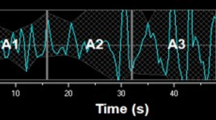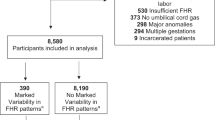Abstract
Fetal heart rate (FHR) monitoring is used routinely in labor, but conventional methods have a limited capacity to detect fetal hypoxia/acidosis. An exploratory study was performed on the simultaneous assessment of maternal heart rate (MHR) and FHR variability, to evaluate their evolution during labor and their capacity to detect newborn acidemia. MHR and FHR were simultaneously recorded in 51 singleton term pregnancies during the last two hours of labor and compared with newborn umbilical artery blood (UAB) pH. Linear/nonlinear indices were computed separately for MHR and FHR. Interaction between MHR and FHR was quantified through the same indices on FHR–MHR and through their correlation and cross-entropy. Univariate and bivariate statistical analysis included nonparametric confidence intervals and statistical tests, receiver operating characteristic curves and linear discriminant analysis. Progression of labor was associated with a significant increase in most MHR and FHR linear indices, whereas entropy indices decreased. FHR alone and in combination with MHR as FHR–MHR evidenced the highest auROC values for prediction of fetal acidemia, with 0.76 and 0.88 for the UAB pH thresholds 7.20 and 7.15, respectively. The inclusion of MHR on bivariate analysis achieved sensitivity and specificity values of nearly 100 and 89.1 %, respectively. These results suggest that simultaneous analysis of MHR and FHR may improve the identification of fetal acidemia compared with FHR alone, namely during the last hour of labor.




Similar content being viewed by others
References
Ayres-de-Campos D, Sousa P, Costa A, Bernardes J (2008) Omniview-SisPorto 3.5—a central fetal monitoring station with online alerts based on computerized cardiotocogram+ST event analysis. J Perinat Med 36:260–264
Bakker P, van Geijn H (2008) Uterine activity: implications for the condition of the fetus. J Perinat Med 36:30–37
Bernardes J, Costa-Pereira A, Ayres-de-Campos D, van Geijn HP, Pereira-Leite L (1997) Evaluation of interobserver agreement of cardiotocograms. Int J Gynaecol Obstet 57:33–37
Carter MC (1993) Signal processing and display—cardiotocographs. Br J Obstet Gynaecol 100:21–23
DiPietro JA (2012) Maternal stress in pregnancy: considerations for fetal development. J Adolescent Health 51:S3–S8
Dudenhausen JW, Luhr C, Dimer JS (1997) Umbilical artery blood gases in healthy term newborn infants. Int J Gynaecol Obstet 57:251–258
Dudewicz E, Mishra S (1998) Modern mathematical statistics. Wiley, New York
Georgieva A, Moulden M, Redman CWG (2013) Umbilical cord gases in relation to the neonatal condition: the EveREst plot. Eur J Obstet Gynecol Reprod Biol 168:155–160
Georgieva A, Papageorghiou AT, Payne SJ, Moulden M, Redman CWG (2014) Phase-rectified signal averaging for intrapartum electronic fetal heart rate monitoring is related to acidaemia at birth. BJOG 121:889–894
Gonçalves H, Rocha AP, Ayres-de-Campos D, Bernardes J (2006) Internal versus external intrapartum foetal heart rate monitoring: effect on linear and nonlinear parameters. Physiol Meas 27:307–319
Gonçalves H, Rocha AP, Ayres-de-Campos D, Bernardes J (2006) Linear and nonlinear fetal heart rate analysis of normal and acidemic fetuses in the minutes preceding delivery. Med Biol Eng Comput 44:847–855
Gonçalves H, Henriques-Coelho T, Bernardes J, Rocha AP, Nogueira A, Leite-Moreira A (2008) Linear and nonlinear heart-rate analysis in a rat model of acute anoxia. Physiol Meas 29:1133–1143
Gonçalves H, Henriques-Coelho T, Rocha AP, Lourenço AP, Leite-Moreira A, Bernardes J (2013) Comparison of different methods of heart rate entropy analysis during acute anoxia superimposed on a chronic rat model of pulmonary hypertension. Med Eng Phys 35:559–568
Gonçalves H, Costa A, Ayres-de-Campos D, Costa-Santos C, Rocha AP, Bernardes J (2013) Comparison of real beat-to-beat signals with commercially available 4 Hz sampling on the evaluation of foetal heart rate variability. Med Biol Eng Comput 51:665–676
Hanson L (2010) Risk management in intrapartum fetal monitoring: accidental recording of the maternal heart rate. J Perinat Neonatal Nurs 24:7–9
Hellgren C, Akerud H, Jonsson M, Sundström Poromaa I (2011) Sympathetic reactivity in late pregnancy is related to labour onset in women. STRESS 14:627–633
Jonsson M, Nordén-Lindeberg S, Östlund I, Hanson U (2008) Acidemia at birth, related to obstetric characteristics and to oxytocin use, during the last two hours of labour. Acta Obstet Gynecol Scand 87:745–750
Kwon JY, Park IY, Shin JC, Song J, Tafreshi R, Lim J (2012) Specific change in spectral power of fetal heart rate variability related to fetal acidemia during labour. Early Hum Dev 88:203–207
Lu S, Chen X, Kanters JK, Solomon IC, Chon KH (2008) Automatic selection of the threshold value r for approximate entropy. IEEE Trans Biomed Eng 55:1966–1972
Martinez WL, Martinez AR (2002) Computational statistics handbook with MATLAB. CRC Press, Boca Raton
May LE, Suminski RR, Berry A, Langaker MD, Gustafson KM (2014) Maternal physical activity mode and fetal heart outcome. Early Hum Dev 90:365–369
Murray ML (2004) Maternal or fetal heart rate? Avoiding intrapartum misidentification. J Obstet Gynecol Neonatal Nurs 33:93–104
Nurani R, Chandraharan E, Lowe V, Ugwumadu A, Arulkumaran S (2012) Misidentification of maternal heart rate as fetal on cardiotocography during the second stage of labor: the role of the fetal electrocardiograph. Acta Obstet et Gynecol Scand 91:1428–1432
Pincus S (1991) Approximate entropy as a measure of system complexity. Proc Natl Acad Sci USA 88:2297–2301
Pincus S, Viscarello R (1992) Approximate entropy: a regularity measure for fetal heart rate analysis. Obstet Gynecol 79:249–255
Pinto P, Bernardes J, Costa-Santos C, Amorim-Costa C, Silva M, Ayres-de-Campos D (2014) Development and evaluation of an algorithm for computer analysis of maternal heart rate during labor. Comput Biol Med 49:30–35
Richman JS, Moorman JR (2000) Physiological time-series analysis using approximate entropy and sample entropy. Am J Physiol Heart Circ Physiol 278:H2039–H2049
Sá Couto P, van Meurs W, Bernardes J, Marques de Sá J, Goodwin J (2002) Mathematical model for educational simulation of the oxygen delivery to the fetus. Control Eng Pract 10:59–66
Schulz S, Adochiei FC, Edu IR, Schroeder R, Costin H, Bar KJ, Voss A (2013) Cardiovascular and cardiorespiratory coupling analyses: a review. Philos Tran A Math Phys Eng Sci 371:20120191
Sherman DJ, Frenkel E, Kurzweil Y, Padua A, Arieli S, Bahar M (2002) Characteristics of maternal heart rate patterns during labor and delivery. Obstet Gynecol 99:542–547
STAN Service Manual (2005) Neoventa, Sweden
Suzuki T, Okamura K, Kimura Y, Watanabe T, Yaegashi N, Murotsuki J, Uehara S, Yajima A (2000) Power spectral analysis of R–R interval variability before and during the sinusoidal heart rate pattern in fetal lambs. Am J Obstet Gynecol 182:1227–1232
Task force of the European Society of Cardiology and the North American Society of Pacing and Electrophysiology (1996) Heart rate variability—standards of measurement, physiological interpretation and clinical use. Circ 17:354–381
Yeh P, Emary K, Impey L (2012) The relationship between umbilical cord arterial pH and serious adverse neonatal outcome: analysis of 51 519 consecutive validated samples. BJOG 119:824–831
Acknowledgments
Hernâni Gonçalves is financed by a post-doctoral grant (SFRH/BPD/69671/2010) from the Fundação para a Ciência e a Tecnologia (FCT), Portugal.
Author information
Authors and Affiliations
Corresponding author
Rights and permissions
About this article
Cite this article
Gonçalves, H., Pinto, P., Silva, M. et al. Toward the improvement in fetal monitoring during labor with the inclusion of maternal heart rate analysis. Med Biol Eng Comput 54, 691–699 (2016). https://doi.org/10.1007/s11517-015-1359-7
Received:
Accepted:
Published:
Issue Date:
DOI: https://doi.org/10.1007/s11517-015-1359-7




